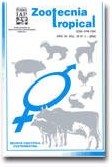
|
Zootecnia Tropical
Instituto Nacional de Investigaciones Agrícolas Venezuela
ISSN: 0798-7269
Vol. 26, No. 2, 2008, pp. 141-150
|
 Bioline Code: zt08018
Bioline Code: zt08018
Full paper language: Spanish
Document type: Research Article
Document available free of charge
|
|
|
Zootecnia Tropical, Vol. 26, No. 2, 2008, pp. 141-150
| es |
Evaluación de Dos Criterios de Utilidad en un Programa de Control de la Infección Por Nematodos Gastrointestinales en Ovinos Mediante Tratamiento Antihelmíntico Selectivo
Morales, Gustavo; Sandoval, Espartaco; Pino, Luz A. & Rondón, Zoraida
Resumen
Un lote de ovinos jóvenes (borregos y borregas) seleccionados como reproductores de reemplazo e infestados con nematodos gastrointestinales bajo condiciones naturales fueron sometidos durante 9 meses a evaluaciones hematológicas: hematocrito (Ht) y hemoglobina y a exámenes coproscópicos cuantitativos mediante la técnica de McMaster. Los animales fueron clasificados considerando los resultados de la coproscopía cuantitativa en acumuladores o wormy animals (≥ 800 hpg, Tratar) y no acumuladores (< 800 hpg, no tratar). Al utilizar los valores del hematocrito se conformaron nuevamente dos grupos: Ht≤22%, tratar y Ht:>22%, no tratar. La combinación del recuento de hpg, el valor hematocrito mas el de la hemoglobina fueron usados para clasificar a los animales como resistentes, resilientes y sensibles o wormy animals, primero manualmente y luego con la ayuda del análisis discriminante se realizó la reubicación de los animales en los grupos a los cuales fueron asignados por dicho método. Los valores del hematocrito y del peso resultaron similares entre los ovinos resistentes y resilientes, pero muy superiores con respecto a los sensibles, mientras que al considerar el recuento de los hpg, los que resultaron similares fueron los animales clasificados como sensibles y los resilientes, pero en ambos casos con recuentos de los hpg muy superiores al de los resistentes Al evaluar los criterios de selección sobre la cantidad de ovinos que requerían de tratamiento mensualmente y en total al final del ensayo, se observó que la cantidad de ovinos a tratar varia si la selección se hace considerando los resultados de la coproscopía cuantitativa, el valor hematocrito o la condición de resistente, resiliente ó sensible. El tamaño de dicha fracción resulta similar si utilizamos los resultados de la coproscopía (10,8%) o del valor hematocrito (11,5%) independientemente, pero muy inferior cuando se usa dicha información en forma conjunta (2,93%), ya que al discriminar los animales como resilientes, resistentes o sensibles, los tratamientos se concentran en este último grupo que representa la fracción mas pequeña al interior del rebaño. Se discute la utilidad de los diferentes criterios de selección de la fracción de ovinos a ser tratados, como base de una adecuada estrategia de control de la infección por estróngilos digestivos en condiciones naturales.
Palabras-clave
nematodos gastrointestinales, estróngilos digestivos, hematología, resistencia, resiliencia, sensible.
|
| |
| en |
Evaluation of Two Utility Criteria in a Program of Control of the Infection For Fastrointestinal Nematodes in Sheep by Means of Selective Antihelmintic Treatment
Morales, Gustavo; Sandoval, Espartaco; Pino, Luz A. & Rondón, Zoraida
Abstract
A lot of sheep selected for breeding and naturally infected with gastrointestinal nematodes were submitted during nine months to hematological and quantitative coprological exams. The packed cell volume or haematocrit (Ht) determination was done by means of the microhaematocrit centrifugation method and determined the numbers of strongyle eggs per gram of faces (epg) by the McMaster counting technique. The animals were classified by using the epg counts as wormy animals or parasite accumulators (≥ 800 epg, drench) or not wormy animals (< 800 epg, no drench). When the haematocrit values were used, two groups were established: Ht≤22%, drench and Ht≥23%, no drench. The combination of both criteria plus hemoglobin values, first manually and then by mean of discriminant analysis allowed to classify the sheep in the following categories: resistant (no drench), resilient (no drench), and sensible or wormy animals (drench). The haematocrit values and weight were similar between resilient and resistant sheep, but higher than the sensible. However, for the epg counts there were found no statistical differences between wormy animals and resilient, but in both cases higher than resistant. The goal of these criteria is the identification of animals within the flock that require drug treatment to reduce drug usage. No statistical differences for the numbers of sheep to be drenched were found when the criteria for selecting animals were the haematocrit (11.5%) values or the epg count (10.8%), but in both cases this fraction was higher when the sheep condition (2,93%) was incorporated. These results showed a considerable decrease in number of sheep to be drenched when the classification of an animal as resilient, resistant, or wormy animals was used. The different criteria for selecting sheep for drug treatment in a program of control against gastrointestinal nematode infestation to reduce drug usage are discussed.
Keywords
nematodes, gastrointestinal nematodes, digestive strongyle, hematology, resistant, resilient, sensible.
|
| |
© Copyright 2005 - Zootecnia Tropical
Alternative site location: http://www.sian.inia.gob.ve/repositorio/revistas_ci/ZootecniaTropical/ztindice.htm
|
|
